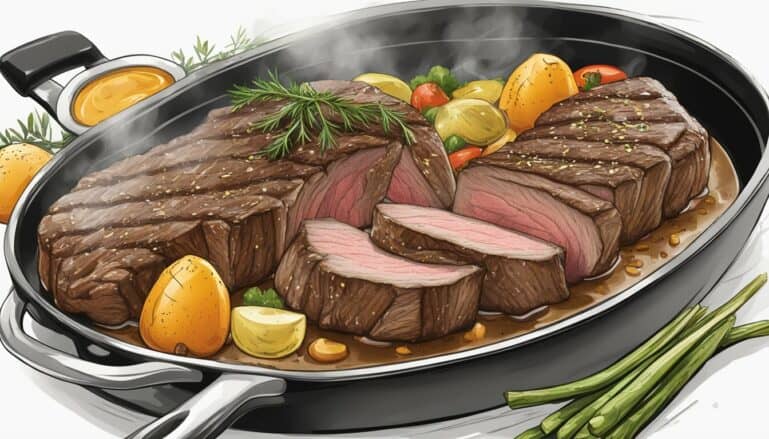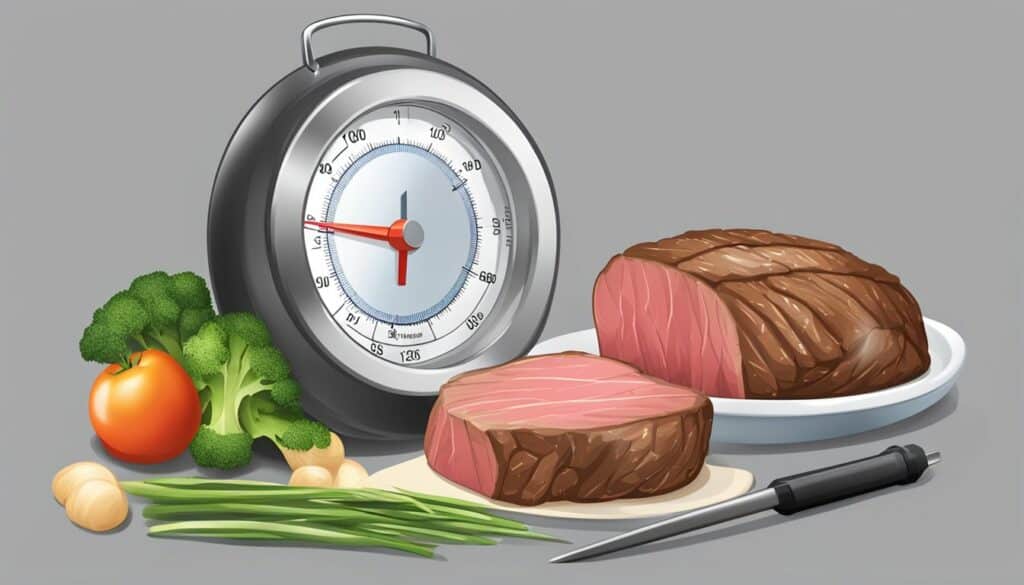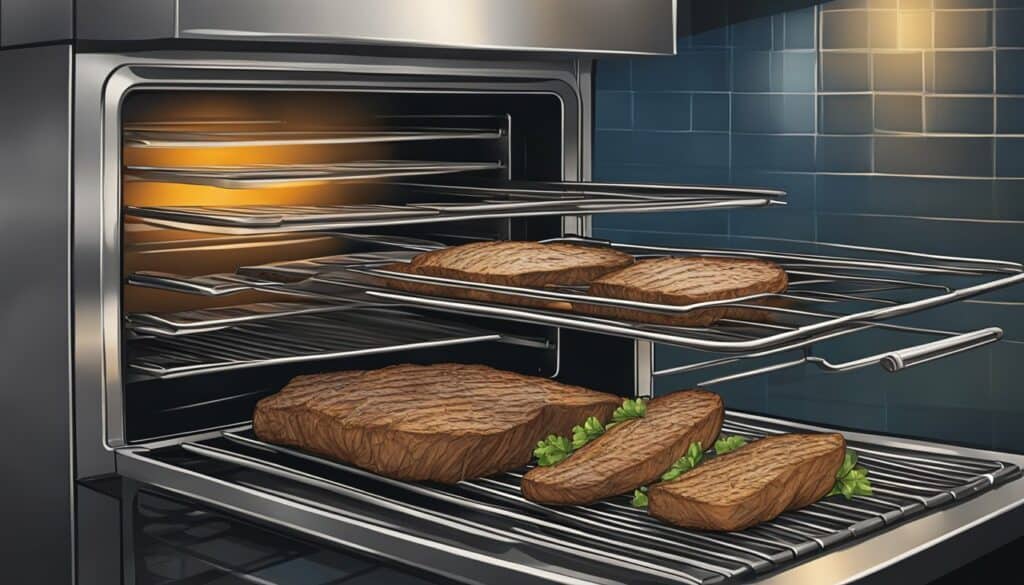How Long to Cook Beef Tenderloin per Pound: A Clear and Confident Guide

Table of Contents
Understanding Beef Tenderloin
Beef tenderloin is a cut of beef that comes from the loin of a cow. It is known for being one of the most tender and highest quality cuts of beef available, which also makes it one of the most expensive.
This lean cut of meat is ideal for cooking whole, as it is relatively uniform in shape and size. The center-cut of the tenderloin is the most desirable, as it is the thickest and most tender part of the cut.
When preparing beef tenderloin, it is important to understand that it is a lean cut of meat and can easily dry out if overcooked. It is recommended to cook the meat to an internal temperature of 135-140°F for a medium-rare finish.
To ensure even cooking, it is recommended to let the meat come to room temperature before cooking and to sear it on high heat before roasting or grilling.
Overall, beef tenderloin is a delicious and luxurious cut of meat that is perfect for special occasions or a fancy dinner party. With proper preparation and cooking techniques, it is sure to impress your guests.
Preparation Before Cooking
Before cooking a beef tenderloin, there are a few steps that need to be taken to ensure the best results. Here are some tips for preparing your beef tenderloin:
-
Trim the beef tenderloin: Before cooking, it is important to trim the beef tenderloin of any excess fat and silverskin. This will help the meat cook more evenly and prevent it from curling up during cooking.
-
Season the beef tenderloin: Season the beef tenderloin generously with kosher salt and freshly ground black pepper. You can also add other seasonings such as garlic, fresh herbs, or a dijon mustard rub to enhance the flavor.
-
Let the beef tenderloin come to room temperature: Take the beef tenderloin out of the refrigerator at least 30 minutes before cooking to allow it to come to room temperature. This will ensure that the meat cooks evenly and is not cold in the center.
-
Preheat the oven: Preheat the oven to 425°F (218°C) before cooking the beef tenderloin.
-
Sear the beef tenderloin: Heat a skillet over high heat and add a tablespoon of olive oil or butter. Sear the beef tenderloin on all sides until browned, about 2-3 minutes per side.
-
Roast the beef tenderloin: Transfer the seared beef tenderloin to a roasting pan and place it in the preheated oven. Roast the beef tenderloin until it reaches your desired internal temperature, about 15-20 minutes per pound for medium-rare.
By following these preparation steps, you can ensure that your beef tenderloin is cooked to perfection and has a delicious flavor.
Choosing Your Cooking Equipment
When it comes to cooking beef tenderloin, choosing the right cooking equipment is crucial. Here are some options to consider:
- Oven: Most beef tenderloin recipes require an oven. Make sure your oven is preheated to the correct temperature before cooking.
- Rack: A rack is useful for allowing air to circulate around the beef tenderloin while it cooks. Consider using a wire rack or a roasting pan with a built-in rack.
- Roasting pan: A roasting pan is a good option for cooking beef tenderloin. Look for a pan with high sides to prevent any juices from spilling over.
- Meat thermometer: A meat thermometer is essential for ensuring that your beef tenderloin is cooked to the correct temperature. Look for a probe thermometer that can be inserted into the thickest part of the beef tenderloin.
- Instant-read thermometer: An instant-read thermometer is a good option for quickly checking the temperature of your beef tenderloin without having to open the oven door.
- Wire rack: A wire rack is useful for allowing air to circulate around the beef tenderloin while it cools. Consider using a wire rack to cool the beef tenderloin after it has finished cooking.
- Cast-iron skillet: A cast-iron skillet is a good option for searing the beef tenderloin before roasting it in the oven.
- Digital thermometer: A digital thermometer is a good option for quickly checking the temperature of your beef tenderloin without having to open the oven door.
Overall, the key is to choose cooking equipment that will help you achieve the desired level of doneness for your beef tenderloin.

Cooking Process
When it comes to cooking beef tenderloin, it’s important to get the timing and temperature just right. Here’s my recommended process for cooking beef tenderloin to perfection:
-
Preheat your oven to 425°F.
-
Season your beef tenderloin with salt and pepper, or your preferred seasoning.
-
Sear the beef tenderloin in a hot pan on high heat until it is browned on all sides.
-
If desired, wrap the beef tenderloin in foil to help keep it moist during cooking.
-
Place the beef tenderloin on a roasting pan and put it in the preheated oven.
-
Cook the beef tenderloin for approximately 20-25 minutes per pound for medium-rare doneness, or until the internal temperature reaches 135°F.
-
Remove the beef tenderloin from the oven and let it rest for 10-15 minutes before slicing.
It’s important not to overcook the beef tenderloin, as it can become tough and dry. Keep an eye on the internal temperature and remove the beef tenderloin from the oven once it reaches the desired doneness. With this cooking process, you’ll be able to enjoy a perfectly cooked beef tenderloin every time.
Serving Suggestions
When it comes to serving beef tenderloin, there are a few things to keep in mind. Here are some serving suggestions to help you make the most of your meal:
-
Special Occasions: Beef tenderloin is a popular choice for special occasions, such as Christmas dinner or a special birthday celebration. Its tender texture and rich flavor make it a crowd-pleaser that is sure to impress your guests.
-
Main Course: Beef tenderloin is typically served as the main course of a meal. It pairs well with a variety of side dishes, including roasted vegetables, mashed potatoes, and a fresh salad.
-
Guests: If you are serving beef tenderloin to guests, be sure to ask about any dietary restrictions or preferences. You may need to offer a vegetarian option or a gluten-free side dish to accommodate everyone’s needs.
When it comes to cooking beef tenderloin, it’s important to remember that the cooking time will vary depending on the size of the roast. Use a meat thermometer to ensure that the internal temperature reaches 135°F for medium-rare or 145°F for medium.
Once the beef tenderloin is cooked to perfection, let it rest for at least 10 minutes before slicing. This will allow the juices to redistribute throughout the meat, resulting in a more flavorful and tender roast.
Overall, beef tenderloin is a delicious and impressive main course that is perfect for any special occasion. With a little bit of planning and preparation, you can serve up a meal that your guests will be talking about for weeks to come.
Accompaniments and Side Dishes
When it comes to serving beef tenderloin, choosing the right accompaniments and side dishes can make all the difference. Here are some ideas to consider:
-
Potatoes: Roasted potatoes, mashed potatoes, or mashed sweet potatoes all pair well with beef tenderloin. For a twist, try adding horseradish or rosemary to your mashed potatoes.
-
Vegetables: Green beans, asparagus, and mushrooms are all great options for adding some color and nutrition to your plate. Roasting or sautéing them with garlic and thyme can add some extra flavor.
-
Horseradish sauce: A classic accompaniment to beef tenderloin, horseradish sauce adds a tangy kick that complements the rich flavor of the meat.
-
Red wine: A full-bodied red wine, such as Cabernet Sauvignon or Merlot, can be a great pairing with beef tenderloin. Look for a wine with bold tannins and a fruity finish.
-
Peppercorns: Crushed peppercorns can add some spice and texture to your beef tenderloin. Try coating the meat with a mixture of crushed peppercorns and coarse salt before roasting.
-
Baking dish: When cooking beef tenderloin, it’s important to use a baking dish that is just the right size. Too big, and the meat may dry out; too small, and it may not cook evenly.
Overall, the key to a successful beef tenderloin dinner is to keep it simple and let the natural flavor of the meat shine through. With a few well-chosen accompaniments and side dishes, you can create a meal that is both elegant and satisfying.
Post Cooking Tips
After cooking the beef tenderloin, there are some essential tips to keep in mind to ensure that the meat remains tender and flavorful. Here are some post-cooking tips that you should consider:
-
Avoid overcooking: Overcooking the beef tenderloin can result in a dry and tough texture. It is crucial to monitor the internal temperature of the meat regularly to avoid overcooking it.
-
Let it rest: Once the beef tenderloin is cooked, let it rest on a cutting board for at least 10 to 15 minutes before carving. This allows the juices to redistribute throughout the meat, making it more tender and flavorful.
-
Remove the silver skin: The silver skin is a tough connective tissue that covers the beef tenderloin. It is essential to remove it before cooking to ensure a tender and buttery texture.
-
Reheat properly: If you have any leftovers, it is crucial to reheat the beef tenderloin properly. You can do this by placing it in an oven at 325°F for 10 to 15 minutes or until it reaches an internal temperature of 135°F.
-
Use a sharp knife: When carving the beef tenderloin, use a sharp knife to ensure clean and straight cuts. This will help to preserve the texture and flavor of the meat.
-
Keep it tied: If you have tied the beef tenderloin before cooking, it is essential to keep it tied while it rests. This helps to maintain its shape and prevent the juices from running out.
These tips will help you to enjoy a delectable and straightforward beef tenderloin dish. If you have any questions or concerns, refer to our FAQ section or consult a professional chef.

Specific Recipes
When it comes to cooking beef tenderloin, there are countless recipes to choose from. Here are a few specific recipes to try:
-
Classic Roasted Beef Tenderloin: Rub the beef tenderloin with sea salt and let it sit at room temperature for an hour. Preheat the oven to 425°F. Sear the beef tenderloin in a hot skillet for 3-4 minutes on each side. Transfer the beef tenderloin to a roasting pan and roast for 25-30 minutes, or until the internal temperature reaches 135°F for medium-rare. Let the beef tenderloin rest for 10-15 minutes before slicing and serving.
-
Herb-Crusted Beef Tenderloin: Mix together chopped fresh herbs (such as rosemary, thyme, and parsley), minced garlic, and olive oil. Rub the mixture all over the beef tenderloin. Preheat the oven to 425°F. Roast the beef tenderloin for 25-30 minutes, or until the internal temperature reaches 135°F for medium-rare. Let the beef tenderloin rest for 10-15 minutes before slicing and serving.
-
Bacon-Wrapped Beef Tenderloin: Wrap the beef tenderloin in bacon slices, securing them with toothpicks. Preheat the oven to 425°F. Roast the beef tenderloin for 25-30 minutes, or until the internal temperature reaches 135°F for medium-rare. Let the beef tenderloin rest for 10-15 minutes before slicing and serving.
No matter which recipe you choose, it’s important to let the beef tenderloin rest before slicing it. This allows the juices to redistribute and ensures a tender, juicy roast.
It’s also important to note that beef tenderloin is a lean cut of meat, which means it can dry out quickly if overcooked. Keep an eye on the internal temperature and remove the beef tenderloin from the oven as soon as it reaches the desired level of doneness.
If you’re unsure about how to cook beef tenderloin, don’t hesitate to ask your local butcher for advice. They can help you choose the right cut of meat and provide tips for cooking it perfectly. And remember to always pat the beef tenderloin dry with paper towels before cooking to remove any excess moisture and ensure a crispy, golden-brown crust.